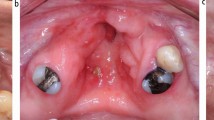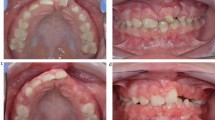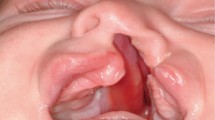Abstract
This clinical paper outlines the role of the restorative consultant in the treatment of young cleft lip and palate patients up to the end of their cleft package of care on their 22nd birthday. The multidisciplinary nature of the care is highlighted, including the role of the general dental practitioner in caring for cleft patients in primary care. The various clinical treatment modalities used in this patient group are described with an emphasis on minimally invasive and adhesive approaches. The role of dental implants and removable prostheses are described. Considerations for long-term maintenance, much of which will take place in primary care, are also included.
Key points
-
Outlines the multidisciplinary nature of cleft care for specialists and speciality trainees.
-
Outlines the role of the general dental practitioner in the care of cleft patients.
-
Highlights the minimally invasive nature of the treatment provided for this patient group
This is a preview of subscription content, access via your institution
Access options
Subscribe to this journal
Receive 24 print issues and online access
$259.00 per year
only $10.79 per issue
Buy this article
- Purchase on Springer Link
- Instant access to full article PDF
Prices may be subject to local taxes which are calculated during checkout









Similar content being viewed by others
References
NHS England. NHS standard contract for cleft lip and/or palate services including non-cleft velopharyngeal dysfunction (VPD) (all ages). Available at https://www.england.nhs.uk/wp-content/uploads/2013/06/d07-cleft-lip.pdf (accessed June 2023).
Van Dyck J, Cadenas de Llano-Pérula M, Willems G, Verdonck A. Dental development in cleft lip and palate patients: A systematic review. Forensic Sci Int 2019; 300: 63-74.
Worth V, Perry R, Ireland T, Wills A K, Sandy J, Ness A. Are people with an orofacial cleft at a higher risk of dental caries? A systematic review and meta-analysis. Br Dent J 2017; 223: 37-47.
Tannure P N, Oliveira C A, Maia L C, Vieira A R, Granjeiro J M, de Castro Costa M. Prevalence of dental anomalies in nonsyndromic individuals with cleft lip and palate: a systematic review and meta-analysis. Cleft Palate Craniofac J 2012; 49: 194-200.
Shen C-A, Guo R, Li W. Enamel defects in permanent teeth of patients with cleft lip and palate: A cross-sectional study. J Int Med Res 2019; 47: 2084-2096.
NHS England. Treatment: Cleft lip and palate. 2023. Available at https://www.nhs.uk/conditions/cleft-lip-and-palate/treatment/ (accessed October 2022).
Kokich V O, Kokich V G, Kiyak H A. Perceptions of dental professionals and laypersons to altered dental esthetics: asymmetric and symmetric situations. Am J Orthod Dentofacial Orthop 2006; 130: 141-151.
Zarone F, Leone R, Di Mauro M I, Ferrari M, Sorrentino R. No-preparation ceramic veneers: a systematic review. J Osseointegrat 2018; 10: 17-22.
Frese C, Schiller P, Staehle H J, Wolff D. Recontouring teeth and closing diastemas with direct composite buildups: a 5-year follow-up. J Dent 2013; 41: 979-985.
Miettinen M, Millar B. A review of the success and failure characteristics of resin-bonded bridges. Br Dent J 2013; DOI: 10.1038/sj.bdj.2013.686.
King P A, Foster L V, Yates R J, Newcombe R G, Garrett M J. Survival characteristics of 771 resin-retained bridges provided at a UK dental teaching hospital. Br Dent J 2015; 218: 423-428.
Wang F, Wu Y, Zou D, Wang G, Kaigler D. Clinical outcomes of dental implant therapy in alveolar cleft patients: a systematic review. Int J Oral Maxillofac Implants 2014; 29: 1098-1105.
Wermker K, Jung S, Joos U, Kleinheinz J. Dental implants in cleft lip, alveolus, and palate patients: a systematic review. Int J Oral Maxillofac Implants 2014; 29: 384-390.
Acknowledgements
The authors would like to acknowledge Mr Martin Ashley, Consultant in Restorative Dentistry at Manchester Dental Hospital, for his kind assistance in the preparation of this manuscript.
Guest Editor, Sandip Popat, was not involved in the peer review process of this manuscript.
Author information
Authors and Affiliations
Contributions
Simon Critchlow and Sandip Popat contributed equally to the preparation of this manuscript.
Corresponding author
Ethics declarations
The authors declare no conflicts of interest.
Written consent to publish has been obtained for Figure 3.
Rights and permissions
About this article
Cite this article
Critchlow, S., Popat, S. Restorative dentistry in the young cleft patient. Br Dent J 234, 881–886 (2023). https://doi.org/10.1038/s41415-023-5997-0
Received:
Revised:
Accepted:
Published:
Issue Date:
DOI: https://doi.org/10.1038/s41415-023-5997-0
This article is cited by
-
The restorative dentistry management of adult cleft patients: 'the adult returner'
British Dental Journal (2023)



